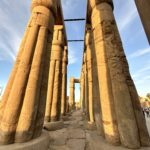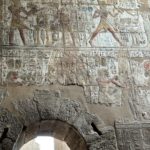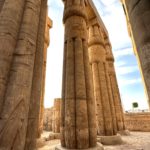buy prednisolone for dogs uk Fly to Luxor to embark the h/s Nebu
After a very early breakfast, we transferred to the Cairo airport at 5:00 am for our flight to Luxor — the ancient Egyptian city of Thebes.
Upon arrival, drove through lush farmlands to the Nile waterfront, where the Vantage-owned ship h/s Nebu waited for us to climb aboard for our Nile cruise. We were greeted with a taste of hibiscus juice which they drink either tart or sweet. We checked in to settle into our spacious suites with bed, dressing area, sitting area and bathroom. Before lunch, we explored the decks of the boat, ending up on the sundeck with its pool. Buffet lunch was served in the restaurant consisting of assorted fruits, vegetables, meats, and pasta. For a first this trip, ice cream found its way to the dessert buffet – mango ice cream.
After lunch, we had our safety briefing in the lounge and a discussion of the rest of the day’s activities. Then, we were treated to a documentary detailing egyptologists discoveries in the Valley of Kings including highly detailed graphic representations of the kings’ crossing of the Netherworld with the sun god, RA (basically when they take to their solar boat and travel with RA through the night to rebirth).
Since our bags had to be out in the hall at the hotel at 4 am, they gave us 2 hours to take a power nap and get ourselves together for a visit to the Luxor Temple complex.
A walkway lined with rams-head sphinxes leads all the way from the Karnak complex to the 3,500-year-old Luxor Temple complex. Dedicated to the Theban Triad of Amun, Mut, and Khonsu, Luxor’s graceful inner courtyards are lined with Rameses colossi and graceful columns covered in carvings and hieroglyphics. It is an elegant example of Pharaonic temple architecture. It was largely completed by the 18th dynasty pharaoh Amenhotep III and added to during the reign of Ramses II in the 19th dynasty. The temple was further modified by later rulers, including Alexander the Great. Its design is remarkably coherent compared to its neighbor the sprawling complex of Karnak. During 3rd century AD it was occupied by a Roman camp and was subsequently abandoned. Over the centuries, it was engulfed in sand and silt and a village grew up within the temple walls. Then in 1881 archaeologist Gaston Maspero rediscovered the temple but before excavation could begin the village had to be removed. Only the Abu al-Haggag Mosque built by Arabs in 13th century was left intact standing high on the layers of silt accumulated over the years. Fronting the entrance to the temple, the gigantic first pylon is decorated with scenes of Ramses victories over the Hittites in the battle of Qadesh. Two enormous colossi of Ramses and a huge 82 foot high pink granite obelisk flank the gateway to the temple. The obelisk was one of a pair, the other was removed in the early 19th century and re-erected in Place de la Concorde in Paris, a gift from Egyptian ruler Mohammed Ali to the people of France. Beyond the first pylon lies the Court of Ramses II with Abu al-Haggag Mosque towering over the courtyard to the east. The height of the mosque over the stone floor is a visual indication of the depth of debris that once covered the entire temple. The western corner of the court incorporates an earlier barque shrine (to house the god’s sacred boats) dedicated to the Theban Triad. A double row of papyrus bud columns encircles the court, interspersed with huge standing colossi of Ramses II. More giant black granite statues of Ramses guard the entrance to the original part of the temple, which begins with the majestic colonnade of Amenhotep III with its avenue of 14 columns. The walls here were embellished during the reign of Tutankhamen and depict the Opet festival when the images of Amun, Mut, and Khonsu were taken in procession from Karnak to Luxor. The western wall shows the outward journey to Luxor and the eastern wall the return to Karnak. The colonnade leads to the Court of Amenhotep III noted for its double rows of papyrus columns, the best preserved in the temple. In 1989 work on the foundation led to discovery of 22 New Kingdom statues now on display in the Luxor Museum. The hypostyle hall on the southern side served as a vestibule to the main temple. It has 32 papyrus columns in 4 rows of eight bearing the later cartouches of Ramses II, Ramses IV, Ramses VI, and Seti I. The antechamber beyond was converted to a church by the Romans 4th century AD, its Pharaonic reliefs plastered over and covered with Christian paintings. A second smaller antechamber, the offerings chapel, leads on to another columned hall with the Sanctuary of the Sacred Barque in the center. It had been rebuilt by Alexander the Great. The birth room to the east has reliefs depicting the divine birth of Amenhotep III, intended to validate his claim to be the son of Amun. Behind the Sanctuary, another hall leads to a small damaged sanctuary that once housed a gold statue of Amun.
Aurogra online without prescription The Boat-NEBU
The custom-built h/s Nebu offers the finest and newest accommodations sailing the Nile today. With just 40 cabins, it was the most luxurious and exclusive way to sail this ancient waterway. We could cruise to legendary archaeological sites, relax on the sun deck, take a dip in the swimming pool, savor delectable cuisine, or relax in our spacious cabin. Staterooms offered private bathroom with bathtub and hair dryer, sitting area, individually controlled air-conditioning, minibar, safe, telephone, and TV with video channels.
- Staterooms (counting suites): 40
- 4 Supplement-free solo cabins
- A restaurant featuring sumptuous international cuisine
- A bar/lounge, perfect for socializing or enjoying onboard entertainment
- A sun deck and swimming pool on the top deck
- Top-deck breakfast dining
- A fitness center, actually a treadmill and a stationary bike
- An elevator
- Onboard spa
- All staterooms feature a private bathroom and hairdryer, sitting area, large windows for optimal views, individual temperature controls, minibar, safe, telephone, and TV with video channels

































